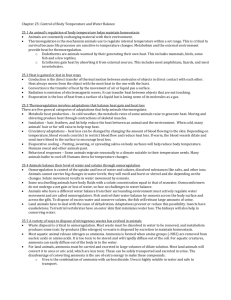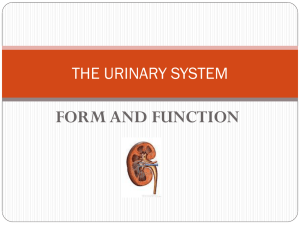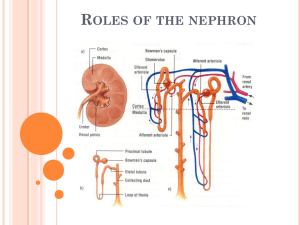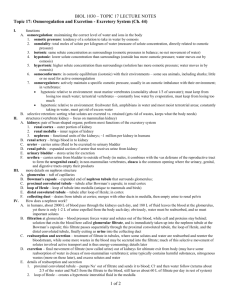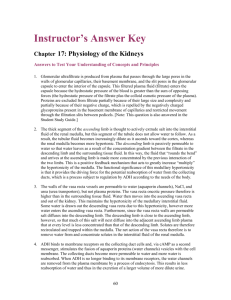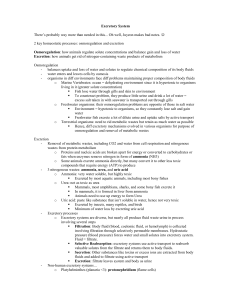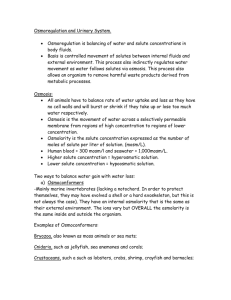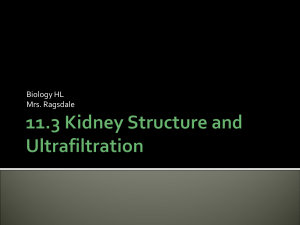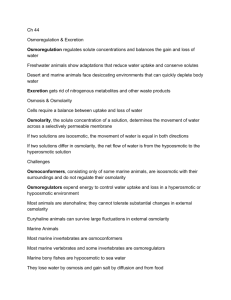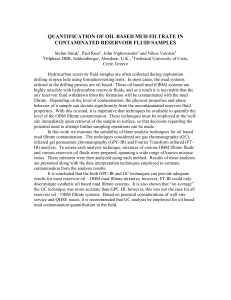Osmoregularity and mammalian reproduction Osmoconformers are
advertisement
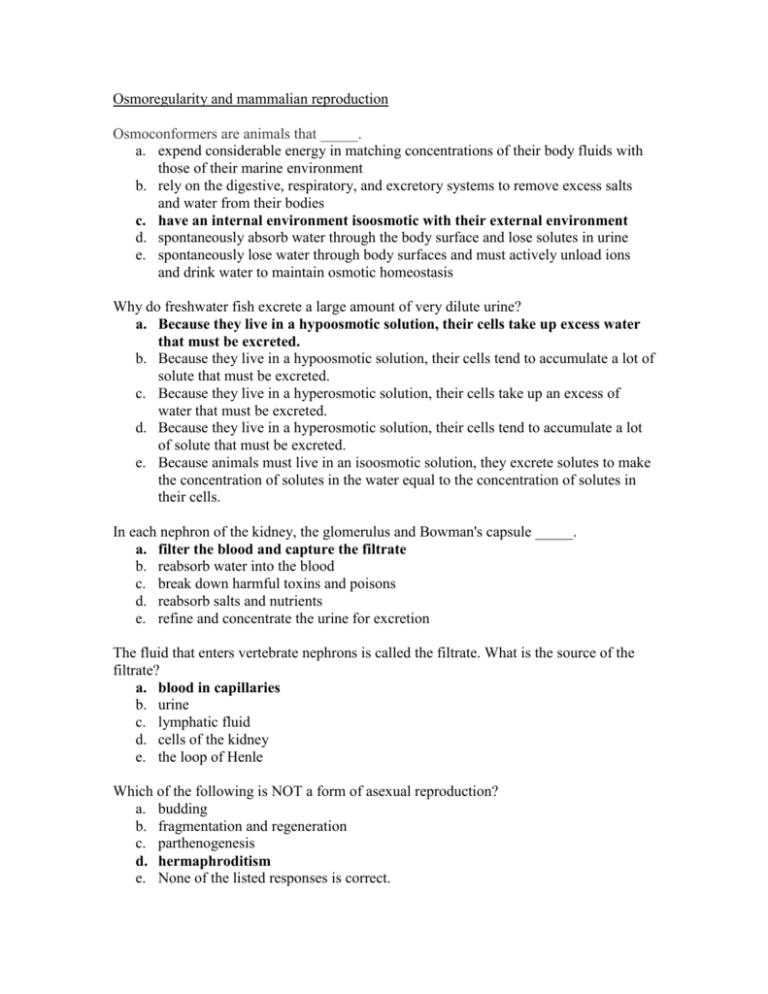
Osmoregularity and mammalian reproduction Osmoconformers are animals that _____. a. expend considerable energy in matching concentrations of their body fluids with those of their marine environment b. rely on the digestive, respiratory, and excretory systems to remove excess salts and water from their bodies c. have an internal environment isoosmotic with their external environment d. spontaneously absorb water through the body surface and lose solutes in urine e. spontaneously lose water through body surfaces and must actively unload ions and drink water to maintain osmotic homeostasis Why do freshwater fish excrete a large amount of very dilute urine? a. Because they live in a hypoosmotic solution, their cells take up excess water that must be excreted. b. Because they live in a hypoosmotic solution, their cells tend to accumulate a lot of solute that must be excreted. c. Because they live in a hyperosmotic solution, their cells take up an excess of water that must be excreted. d. Because they live in a hyperosmotic solution, their cells tend to accumulate a lot of solute that must be excreted. e. Because animals must live in an isoosmotic solution, they excrete solutes to make the concentration of solutes in the water equal to the concentration of solutes in their cells. In each nephron of the kidney, the glomerulus and Bowman's capsule _____. a. filter the blood and capture the filtrate b. reabsorb water into the blood c. break down harmful toxins and poisons d. reabsorb salts and nutrients e. refine and concentrate the urine for excretion The fluid that enters vertebrate nephrons is called the filtrate. What is the source of the filtrate? a. blood in capillaries b. urine c. lymphatic fluid d. cells of the kidney e. the loop of Henle Which of the following is NOT a form of asexual reproduction? a. budding b. fragmentation and regeneration c. parthenogenesis d. hermaphroditism e. None of the listed responses is correct. Which of the following is an example of a mismatch? a. internal fertilization: terrestrial environment b. courtship behavior: aquatic and terrestrial environments c. seasonal sexual maturity: aquatic and terrestrial environments d. external fertilization: terrestrial environments e. eggs released by females to be fertilized by males: aquatic environments Where do developing sperm cells undergo meiosis? a. in the epididymis b. in the vas deferens c. in the seminal vesicle d. in the seminiferous tubules e. in the prostate gland What is the difference between stenohaline and Euryhaline animals? A stenohaline animal cannot tolerate changes to external osmotic environment. Most animals are this. Euryhaline animals can survive large fluctuations. (barnacles and mussels) List and describe the four parts of the excretory process? - Filtration – hydrostatic pressure caused process where water and small solutes cross the epithelial membrane forming a solution called a filtrate. Reabsorption – recovers useful molecules from the filtrate selectively like glucose, some salts, and vitamins. Secretion – nonessential solutes are added to the filtrate selectively by active transport. Excretion – the filtrate is released from the body as urine Where would you find a Metanephridia? How does it work? - Excratory organs that collect fluid directly from the coelem. Each segment of a worm has a pair of them. Immersed in coelomic fluid with a ciliated opening that draws filtrate into a collecting tubule, with a bladder, that opens to the outside. Has both excratory and osmoregulatory functions. Net uptake of water from soil by worms is balance by producing dilute urine. Place the following in the correct order in the path from blood to filtrate. Ascending limb, Distal tubule, proximal tubule, collecting duct, descending limb. 1. Proximal Tubule a. Reabsorption of ions, water, and nutrients. Molecules are transported actively and passively from the filtrate into the interstitial fluid and then into the capillaries. Water follows by osmosis. Some toxic materials are actively secreted into the filtrate. Helps maintain a constant pH in body fluids. 2. Descending limb a. Reabsorption continues. Numerous water channels formed by aquaporin proteins make the transport epithelium more permeable to water. The interstitial 3. 4. 5. 6. fluid is hyperosmotic so water is reabsorbed through osmosis. Solute concentration increases. Ascending Limb a. Transport epithelium is studded with ion channels but not water channels, its impermeable to water. None is able to diffuse. NaCl is moved back out of the filtrate and urine is more dilute. Distal Tubule a. Regulates K and NaCl concentrations of body fluids. The controlled movement of ions contributes to pH regulation. Collecting Duct Carries the filtrate through the medulla into the renal pelvis. Most important task is reabsorption of solutes and water. Compared to body fluids urine is hyperosmotic. True or false: internal fertilization is usually associated with larger number of offspring. FALSE - Internal fertilization is usually associated with the production of fewer gametes but the survival of a higher fraction of zygotes. Eggs are sheltered from potential predators. Internal also is associated with greater care for embryos and the young. What are Spermathecae? Spermathecae – sacs in which sperm can be stored for extended periods. Fertilization can be controlled until conditions are right.
